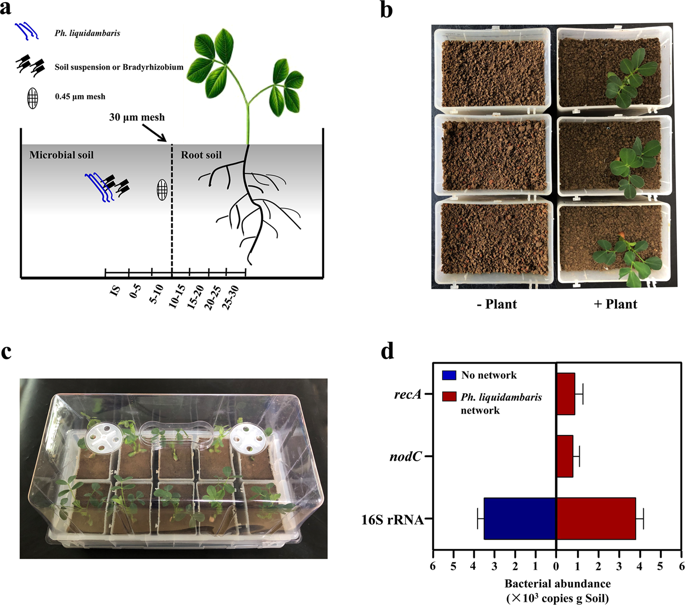Our official English website, www.x-mol.net, welcomes your feedback! (Note: you will need to create a separate account there.)
Mycelial network-mediated rhizobial dispersal enhances legume nodulation.
The ISME Journal ( IF 11.0 ) Pub Date : 2020-01-23 , DOI: 10.1038/s41396-020-0587-5 Wei Zhang 1 , Xiao-Gang Li 2 , Kai Sun 1 , Meng-Jun Tang 1 , Fang-Ji Xu 1 , Ming Zhang 3 , Chuan-Chao Dai 1
The ISME Journal ( IF 11.0 ) Pub Date : 2020-01-23 , DOI: 10.1038/s41396-020-0587-5 Wei Zhang 1 , Xiao-Gang Li 2 , Kai Sun 1 , Meng-Jun Tang 1 , Fang-Ji Xu 1 , Ming Zhang 3 , Chuan-Chao Dai 1
Affiliation

|
The access of rhizobia to legume host is a prerequisite for nodulation. Rhizobia are poorly motile in soil, while filamentous fungi are known to grow extensively across soil pores. Since root exudates-driven bacterial chemotaxis cannot explain rhizobial long-distance dispersal, mycelia could constitute ideal dispersal networks to help rhizobial enrichment in the legume rhizosphere from bulk soil. Thus, we hypothesized that mycelia networks act as vectors that enable contact between rhizobia and legume and influence subsequent nodulation. By developing a soil microcosm system, we found that a facultatively biotrophic fungus, Phomopsis liquidambaris, helps rhizobial migration from bulk soil to the peanut (Arachis hypogaea) rhizosphere and, hence, triggers peanut-rhizobium nodulation but not seen in the absence of mycelia. Assays of dispersal modes suggested that cell proliferation and motility mediated rhizobial dispersal along mycelia, and fungal exudates might contribute to this process. Furthermore, transcriptomic analysis indicated that genes associated with the cell division, chemosensory system, flagellum biosynthesis, and motility were regulated by Ph. liquidambaris, thus accounting for the detected rhizobial dispersal along hyphae. Our results indicate that rhizobia use mycelia as dispersal networks that migrate to legume rhizosphere and trigger nodulation. This work highlights the importance of mycelial network-based bacterial dispersal in legume-rhizobium symbiosis.
中文翻译:

菌丝网络介导的根瘤菌扩散增强了豆科植物的结瘤。
根瘤菌进入豆科植物宿主是结瘤的先决条件。根瘤菌在土壤中的运动性很差,而已知丝状真菌在土壤孔隙中广泛生长。由于根分泌物驱动的细菌趋化性不能解释根瘤菌的长距离扩散,因此菌丝体可以构成理想的扩散网络,以帮助豆科植物根际从散装土壤中富集根瘤菌。因此,我们假设菌丝体网络充当载体,使根瘤菌和豆科植物之间能够接触并影响随后的结瘤。通过开发土壤微观世界系统,我们发现兼性生物营养真菌 Phomopsis liquidambaris 有助于根瘤菌从大块土壤迁移到花生 (Arachis hypogaea) 根际,因此引发花生-根瘤菌结瘤,但在没有菌丝体的情况下看不到。对扩散模式的分析表明,细胞增殖和运动介导了根瘤菌沿菌丝体的扩散,真菌分泌物可能有助于这一过程。此外,转录组学分析表明,与细胞分裂、化学感应系统、鞭毛生物合成和运动相关的基因受 Ph.liquidambaris 的调节,从而解释了检测到的根瘤菌沿菌丝的分散。我们的研究结果表明,根瘤菌使用菌丝体作为扩散网络,迁移到豆科植物根际并引发结瘤。这项工作突出了基于菌丝网络的细菌传播在豆科植物-根瘤菌共生中的重要性。转录组学分析表明,与细胞分裂、化学感应系统、鞭毛生物合成和运动相关的基因受到 Ph.liquidambaris 的调节,从而解释了检测到的根瘤菌沿菌丝的扩散。我们的研究结果表明,根瘤菌使用菌丝体作为扩散网络,迁移到豆科植物根际并引发结瘤。这项工作突出了基于菌丝网络的细菌传播在豆科植物-根瘤菌共生中的重要性。转录组学分析表明,与细胞分裂、化学感应系统、鞭毛生物合成和运动相关的基因受到 Ph.liquidambaris 的调节,从而解释了检测到的根瘤菌沿菌丝的扩散。我们的研究结果表明,根瘤菌使用菌丝体作为扩散网络,迁移到豆科植物根际并引发结瘤。这项工作突出了基于菌丝网络的细菌传播在豆科植物-根瘤菌共生中的重要性。
更新日期:2020-01-23
中文翻译:

菌丝网络介导的根瘤菌扩散增强了豆科植物的结瘤。
根瘤菌进入豆科植物宿主是结瘤的先决条件。根瘤菌在土壤中的运动性很差,而已知丝状真菌在土壤孔隙中广泛生长。由于根分泌物驱动的细菌趋化性不能解释根瘤菌的长距离扩散,因此菌丝体可以构成理想的扩散网络,以帮助豆科植物根际从散装土壤中富集根瘤菌。因此,我们假设菌丝体网络充当载体,使根瘤菌和豆科植物之间能够接触并影响随后的结瘤。通过开发土壤微观世界系统,我们发现兼性生物营养真菌 Phomopsis liquidambaris 有助于根瘤菌从大块土壤迁移到花生 (Arachis hypogaea) 根际,因此引发花生-根瘤菌结瘤,但在没有菌丝体的情况下看不到。对扩散模式的分析表明,细胞增殖和运动介导了根瘤菌沿菌丝体的扩散,真菌分泌物可能有助于这一过程。此外,转录组学分析表明,与细胞分裂、化学感应系统、鞭毛生物合成和运动相关的基因受 Ph.liquidambaris 的调节,从而解释了检测到的根瘤菌沿菌丝的分散。我们的研究结果表明,根瘤菌使用菌丝体作为扩散网络,迁移到豆科植物根际并引发结瘤。这项工作突出了基于菌丝网络的细菌传播在豆科植物-根瘤菌共生中的重要性。转录组学分析表明,与细胞分裂、化学感应系统、鞭毛生物合成和运动相关的基因受到 Ph.liquidambaris 的调节,从而解释了检测到的根瘤菌沿菌丝的扩散。我们的研究结果表明,根瘤菌使用菌丝体作为扩散网络,迁移到豆科植物根际并引发结瘤。这项工作突出了基于菌丝网络的细菌传播在豆科植物-根瘤菌共生中的重要性。转录组学分析表明,与细胞分裂、化学感应系统、鞭毛生物合成和运动相关的基因受到 Ph.liquidambaris 的调节,从而解释了检测到的根瘤菌沿菌丝的扩散。我们的研究结果表明,根瘤菌使用菌丝体作为扩散网络,迁移到豆科植物根际并引发结瘤。这项工作突出了基于菌丝网络的细菌传播在豆科植物-根瘤菌共生中的重要性。



























 京公网安备 11010802027423号
京公网安备 11010802027423号